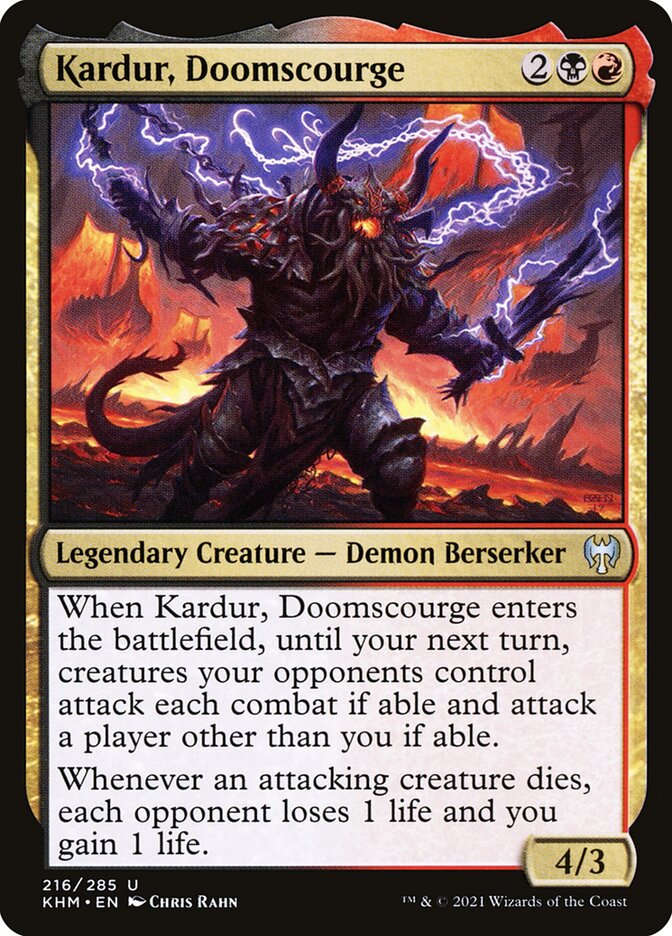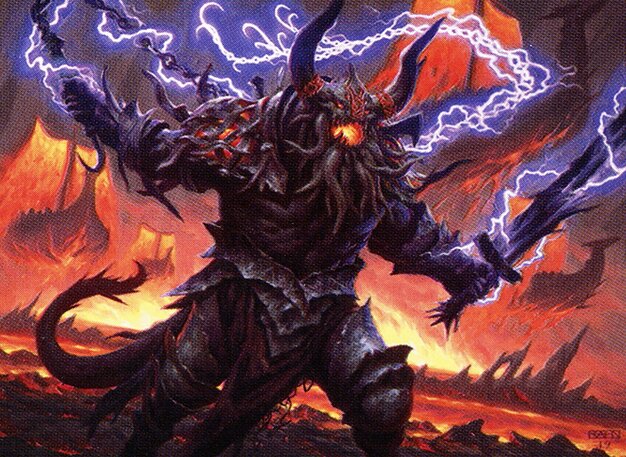Magic the Gathering has had many Legendary Creatures over the years printed at uncommon, dating all the way back to Legends, but not having any appear between then and Champions of Kamigawa. Betrayers of Kamigawa and Saviors of Kamigawa continued the trend of uncommon legendary cards. Then, we saw no more until Dominaria and yet another stretch until Kaldheim. With the return to Kamigawa in Neon Dynasty, it was a foregone conclusion we would see more legendary creatures printed at uncommon.
But, before we delve at all into what Neon Dynasty has to offer on this front, we should first look back at an uncommon Legendary Creature from Kaldheim. This one has languished around the $0.25 status of near bulk, even in its foiled Showcase variant form. yet its substantial headcount in decks scraped by Commander Uber resource EDHREC proves that it requires mention as a long term sleeper in the annals of Magic history.

Avid players of the EDH format are well aware of this cards existence, as it slots into many different types of decks in a very popular color combination of red and black. It also has potential as a solo commander of its own, which merits its own analysis. But, first, what does Kardur do that is so notable that it quietly became used in 6 percent of all possible decks, a rate on par with the powerhouse Goldspan dragon?
How Good are Karbur, Doomscourge’s Abilities?
Kardur, Doomscourge has two strong abilities. The first requires that when he enters the battlefield, until your next turn, creatures your opponent control attack each combat if able and attack a player other than you if able. In a typical one on one duel, this means your opponents creatures are forced to attack you, but bear in mind that this is only for most likely just one combat, and you can plan for this eventuality. In a multi-player game, however, it causes absolute chaos. This ability has been more recently keywords as Goad, and appears on a few highly relevant cards in the Commander format.
The second ability obviously plays into the first but is relevant beyond just that next turn of combat chaos. As long as Kardur is in play, whenever an attacking creature dies, each of your opponents loses one life and you gain one life. Notably, these attacking creatures could even be under your control. This is a potent combination of abilities, but because of the inherent chaos of the first ability and sheer madness that could ensue in a crowded board state, Kardur needs some backup to be successful in putting his planes walker into a winning position.
Before delving into Kardur’s viability as a field general, it’s important to see how this 4/3 four mana Rakdos Demon Berserker fares in the ranks of other Commander decks. The deck in which Kardur is an absolute staple is Karazikar, the Eye Tyrant, best known as the other potential Commander in the product with fast favorite Prosper, tome bound. The Beholder is all about the Goad mechanics, so naturally Kardur is a sure fit. In fact, Karazikar has a complimentary effect to Kardur: whenever an opponent attacks another one of your opponents, both you and that player draw a card and lose 1 life.
Interestingly, Kardur helms more than twice as many decks scraped by EDHREC as of late December 2021. Perhaps, that’s because Kardur doesn’t help opponents draw cards, too.
While no other Commander has adopted Kardur to such a high degree as 91 percent of all lists, plenty of others have deemed to include the Demon Berserker between 20 and 35 percent. One of these is the Jund Spider Thantis, the Warweaver, a Commander deck exclusive many casual fans are likely unfamiliar with. Thantis actually forces all creatures to attack if able, which isn’t often a problem for Thantis herself with vigilance and reach allowing her to play both offense and defense. Thantis also gains a +1/+1 counter whenever a creature attacks you or a planeswalker you control.
Kardur’s utility alongside Thantis should appear relatively obvious, and yet the adoption is far from universal. One could argue that Kardur should be a staple in the deck as his ability in fact will benefit you quite often when Thantis is in play. As to why he appears in fewer than 40 percent of Thantis decks appears to be an oversight.
Kardur Doomscourge as a Tribal Commander
From a tribal deck standpoint, Kardur is an easy recruitment choice for Rakdos the Showstopper. Again, the adoption is limited to fewer than 40 percent of lists. The Showstopper literally can destroy anything that isn’t a Demon, Devil, or Imp when he comes into play. But, that’s only if the creatures he does target happen to be unlucky enough to see their coin flip come up tails. Rakdos the Showstopper is rather gimmicky, but Kardur offers support that seems pretty useful, although not required, depending on how a particular Showstopper deck is structured. We see a similar case with Orcus, Prince of Undeath. Although he is a far less popular commander, with Kardur only popping up in roughly one third of lists.
There is another Commander exclusive that would appear to be the perfect home for Kardur, that is Xantcha, Sleeper Agent. She’s not an incredibly popular commander, but her flavor is off the charts and has strong synergy with Kardur. When Xantcha comes into play, an opponent you choose gains control of her. There are then two benefits you gain from this exchange, one of which can benefit your other opponents, too.
Firstly, Xantcha must attack each combat if able and actually can’t attack its owner or a planeswalker its owner controls. Plus, Xantcha has an activated ability that costs two generic mana and can be used by any player. It makes its controller lose 2 life, and the player who activates it draws a card. This can force some pretty terrible politics, but what do you expect from a color combination so rooted in sowing the seeds of chaos. Anyway, Kardur seems a slam dunk for this deck, to allow you to benefit from Xantcha shenanigans. Yet only roughly a quarter of sleeper agent lists recruit the Doomscourge.
Several other fringe Commanders include Kardur at a similar rate, though there seems to be no discernible synergy strictly between Kardur and the field generals. But, there is one actually rather popular commander that sees fit to include Kardur about one fifth of the time.
Queen Marchesa seems a strange fit for Kardur on the surface, but in her quest to maintain the throne, Goad abilities can prove useful. After all, Karazikar himself shows up in nearly half of all Marchesa decks. Besides that, Marchesa utilizes cards that tax would be attackers, such as Ghostly Prison and Windborn Muse, greatly mitigating the potential back-swing of Kardur’s first ability. We also see many instances of Xantcha agitating opponents in Marchesa decks, too.
Other notable Commanders who have made use of Kardur around 15 percent of the time include Blim, Comedic Genius, Rakdos Lord of Riots, and Mogis, God of Slaughter. Again, none of these Commanders seem like obvious fits, but Kardur finds himself as useful tech in decks like these.
From this data gleaned from EDHREC, it seems Kardur, Doomscourge is actually underplayed in both Xantcha, Sleeper Agent and Queen Marchesa decks. Even a modest bump in inclusion rate would certainly put this Demon Berserker on more radars. Heck, you’d expect more Berserker synergies to eventually call on the services of the Doomscourge.
Finally, we look at Kardur, Doomscourge as a potential field general. In late 2021, he’s about as popular as the aforementioned Xantcha, Sleeper Agent. This puts him outside of the top 250 Commanders but comfortably inside the top 300. That’s nothing to scoff at. Understandably, Kardur decks draw considerable inspiration from Karazikar decks and resemble what you’d expect Goad tribal to look like. The strategy is one that’s relatively new in the Magic world, although cards that forced creatures to attack have been around for years, including the original Kamigawa Era Fumiko the Lowblood.
Where Kardur, Doomscourge can truly shine is including Conjurer’s Closet (or similar effects) in the deck in order to “blink” him and reuse his ability. The Closet can, of course, also do this for a number of other creatures in the deck with potent enter the battlefield abilities such as Vengeful Ancestor. The deck also can take advantage of the third mode of Rakdos Charm as a potential finisher; each creature dealing 1 damage to its controller doesn’t sound like much but with Kardur and supporting drain cards like Blood Artist around, but the inevitable war of attrition is going to lower life totals in range of a surprise Rakdos Charm. Perhaps one of the key cards in the strategy is Curse of Disturbance, creating a ton of Zombie tokens which will ultimately do a lot of smashing into and trading with one another.
Kardur Doomscourge as a Versatile EDH Option
Without going into a full-on strategy guide for Kardur, Doomscourge helmed Commander decks, it’s clear that there’s plenty here for a competitive strategy. Is it top-tier competitive? Probably not, but for those who love to play chaotic strategies that send opponents at each other’s throats, a clever pilot could win a lot of games through a war of attrition.
Does all this make Kardur Doomscourge a candidate as a Kaldheim Hall of Fame sleeper? It’s far too soon to tell, moving into his sophomore year in 2022. For a rookie legendary creature printed at uncommon in a set loaded with Commander all stars, Kardur is certainly in the discussion for best sleeper legendary in the set.
Outside of Commander, Kardur hasn’t really made any waves. According to MTG Top 8, he hasn’t even really appeared in a top 8 setting outside of Kaldheim only sealed deck play, where you’re literally working with cards you open from random packs. But, there’s plenty of content online about all of his potential in Commander, not all of which has yet been fully explored. He may never find himself in any sort of MTG Trading Card Hall of Fame with his own plaque, but Kardur, Doomscourge will certainly be an honorable mention or footnote somewhere along the line.







RECENT COMMENTS